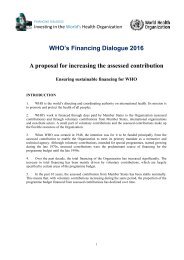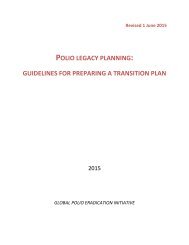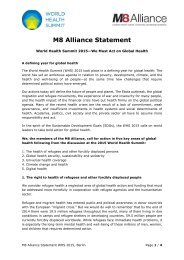Tackling-health-inequities-from-concepts-to-practice-The-experience-of-Vastra-Gotaland
Tackling-health-inequities-from-concepts-to-practice-The-experience-of-Vastra-Gotaland
Tackling-health-inequities-from-concepts-to-practice-The-experience-of-Vastra-Gotaland
- No tags were found...
You also want an ePaper? Increase the reach of your titles
YUMPU automatically turns print PDFs into web optimized ePapers that Google loves.
the implementation <strong>of</strong> their decisions will depend on decisions made byother bodies. Failures <strong>to</strong> implement a certain strategy or actions are thus notnecessarily due <strong>to</strong> what happens in one’s own organization but could well bethe result <strong>from</strong> strategies and decisions at other levels by other ac<strong>to</strong>rs (14).This is a main reason as <strong>to</strong> why a common recommendation for work withinthe field <strong>of</strong> public <strong>health</strong> is <strong>to</strong> emphasize coordination and concerted actionby many different stakeholders within the scientific, public, pr<strong>of</strong>essional andcivic societies (8). To develop the Action Plan, it was necessary <strong>to</strong> organize andcollaborate with a network <strong>of</strong> ac<strong>to</strong>rs in the Region. 2 In the following section, thethree domains that <strong>to</strong>gether form human service organizations are described <strong>to</strong>better understand the limitations and possibilities inherent in the collaborativenetwork that evolved in the regional process. It is clear that a decision is notthe result <strong>of</strong> a linear procedure but rather <strong>from</strong> a situation where a number <strong>of</strong>conditions coincide, by chance or deliberately. <strong>The</strong> process itself was evaluatedusing an ac<strong>to</strong>r-network theory <strong>to</strong> analyse the development process and <strong>to</strong>identify successes and mistakes. <strong>The</strong> core <strong>of</strong> this theory is also accounted for.<strong>The</strong> three domainsIn their <strong>of</strong>ten cited paper, Kouzes and Mico suggest that human serviceorganizations comprise three distinct domains – policy, managment and service– rather than an all-including hierarchy and a linear decision-making process(15). Each <strong>of</strong> the three domains operates by different principles and rationales,measures <strong>of</strong> success, work mode and structures (Table 1). <strong>The</strong>se conflictingprinciples are important explana<strong>to</strong>ry fac<strong>to</strong>rs <strong>to</strong> understand the difficulties thatemerge when political decisions are <strong>to</strong> be implemented in<strong>to</strong> action.Table 1. <strong>The</strong> three domains <strong>of</strong> human service organizationsDomain Principles Success measuresPolicy Consent <strong>of</strong> the governed EquityManagement Hierarchical control and coordination Cost efficiency and effectivenessService Au<strong>to</strong>nomy and self-regulation Quality <strong>of</strong> service, good standardsand <strong>practice</strong>Source: information based on Kouzes & Mico (15).2An overview <strong>of</strong> the organizations involved is in Section 4.Section 3. <strong>The</strong>oretical framework11









